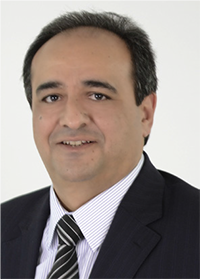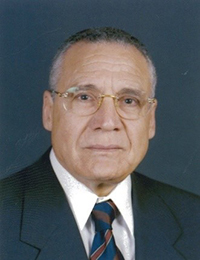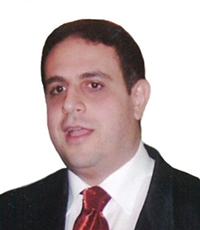IN MEMORY OF A GREAT EGYPTIAN ENGINEER
Prof. William Selim Hanna was born in Assiut, Egypt in 1896. He graduated from El-Mohandeskhana (now the Faculty of Engineering, Cairo University) in 1920. He received his PhD from Birmingham University, UK in 1926. After completing his postgraduate studies, he was appointed as a lecturer in the Structural Engineering Department at Fouad El-Awal University (now Cairo University). In 1932, he became the Director of the new Research Laboratory of Reinforced Concrete Structures.
One of the greatest achievement of Prof. Hanna is laying the foundations of the modern soil mechanics in Egypt, Africa and the Arab World. Prof. Hanna was the first Egyptian to publish a research paper in the field of soil mechanics in Stockholm in 1930. He established the Soil Mechanics Laboratories in Cairo University in 1933. This laboratory is the first soil mechanics laboratory in the Middle East and Africa, and the third worldwide. During this golden age for Cairo University, Prof. Hanna collaborated with other well-known pioneers in field of geotechnical engineering such as Prof. Karl V. Terzaghi, Prof. M. Kamal Khalifa and Prof. Gregory P. Tschebotarioff who later moved from Cairo University to Princeton University, USA as a professor of soil mechanics. Prof. Hanna headed the Laboratory since its founding in 1933 until 1952 when he became a cabinet minister. In 1973, he was awarded the State Prize of Merit becoming the first scientist in the field of Soil Mechanics and Foundations to receive this prestigious award.
In 1941, Dr. Hanna was nominated as the chair professor for reinforced concrete structures and construction of buildings. In 1949, he introduced the use of prestressed concrete for the first time in Egypt. Prof. Hanna also served as the Egyptian Minister of Public Works during the period of 1952–1954. In the 1950s, Prof. Hanna envisioned the utilization of the underground space for transportation purposes in Cairo. He prepared plans for two underground metro lines along the mid of Cairo and under the Nile. Decades later, his visions came true and the Cairo Metro was built.
In 1966, the UNESCO called for saving the Philae Monuments in Nubia from submergence under the Nile River water after the creation of Lake Nasser upstream of Aswan High Dam. A consultant consortium led by Prof. Hanna, Prof. A. H. El-Ramely and Architect M. Shawky proposed for the civil works in this project. Their proposal won the international competition for these works. The huge international efforts to save Philae Monuments started in the late 1960s. The rescue task was successfully completed in 1980.
The outstanding engineering contributions of Prof. Hanna include the design of the Nile Hilton Hotel, Ramsis Hilton Hotel, the Paper National Company, the Egyptian Company for Industrial Silk, Rakta Paper Company, the Egyptian Company for Chemicals, New Amiria Printing House. He also contributed to the design of many power stations including Talkha, Lybon, Damanhoor and Kafr-El-Dawar Power Stations. Prof. Hanna left our world in 1980 but his memorable contributions to the Egyptian and the international engineering knowledge and practice will always keep his name among the great Egyptians and the distinguished engineers.
Sherif W. Agaiby, PhD, Professor

Prof. Dr. Sherif Wissa Agaiby is the Director of the Geotechnical and Heavy Civil Engineering Department at Dar Al-Handasah Consultants (Shair and Partners). Dr Agaiby earned his B.Sc. and M.Sc. degrees from Cairo University, Egypt in 1983 and 1987, respectively, and his Ph.D. from Cornell University, Ithaca, NY, USA in 1991.
Dr. Agaiby taught and conducted research in most fields of Geotechnical Engineering as a university faculty member (Cairo University; 1983 - 2004). Since joining Dar Al-Handasah, Dr. Agaiby has been actively involved in consulting and has participated in the planning, analyzing, designing, and providing during construction follow-up for major engineering projects worldwide.
Dr. Agaiby is involved in many national and international scientific activities including: Chairperson of the Professional Image Committee, International Society for Soil Mechanics and Geotechnical Engineering (ISSMGE), 2013 to 2017; Board Member, Council of Foundation of ITA-CET, Foundation for Education and Training on Tunneling and Underground Space Use; member of the Egyptian Code of Practice for Geotechnical Engineering and Foundations on Rock committee and the Site Investigation committee; member of the Egyptian Code of Practice committee for the Design and Construction of Tunnels and Underground Structures.
Abdelsalam M. Salem, PhD, Professor

Prof. Dr. Abdelsalam Salem is the Chairman of the Egyptian Geotechnical Society and a distinguished Professor Emeritus at Cairo University. He is a member of the General Committee of the Egyptian National Code of Practice for Geotechnical Engineering and chaired the committees on Earth Retaining Structures, and on Earthworks and Dewatering Systems.
Dr. Salem earned his B.Sc. degree in Civil Engineering in 1963, Diploma in Soil Mechanics and Foundation Engineering in 1966, M.Sc. degree in Geotechnical Engineering from Cairo University, Egypt in 1969 and his doctorate degree from Northwestern University, Illinois, USA in 1975. He then worked as a Visiting Assistant Professor at Northwestern University, as a geotechnical engineer and Section Head at Harza Engineering, Chicago, Illinois, USA before joining the Faculty of Engineering at Cairo University in 1977. In 1978,
Dr. Salem was appointed (part-time) as the Principal of Geotechnical Engineering at Fredric Harris for Major Projects in Egypt for 2 years. Dr. Salem has a long and productive academic career during which he taught many undergraduate and graduate geotechnical engineering courses and supervised more than 50 masters and doctorate students. Dr. Salem has many technical publications in international and national journals and conferences. In addition, Dr. Salem has over 50 years of extensive consulting experience in geotechnical engineering working on hundreds of diverse projects including major infrastructure and industrial projects, many including failure analyses and remediation.
Sayed M. Ahmed, PhD

Dr. Ahmed is an Associate Professor of Geotechnical Engineering at Ain Shams University, Cairo Egypt. He graduated with a Ph.D. from Ain Shams University, Egypt, in 2001. Dr. Ahmed participated in the preparation of the Egyptian Deep Excavation Manual as part of the national code provisions in Egypt and is currently participating in the drafting of the Egyptian Code of Practice for the Design and Construction of Tunnels and Underground Structures. Dr. Ahmed was a member in the geotechnical working groups of the Council of Engineering Sciences at the Academy for Scientific Research and Technology (ASRT), which prepared the roadmaps for the scientific research in Egypt during the period 2014-2015.
An engineering failure may be defined as an unforeseen, substandard, performance of an engineered element. It can materialize in the forms of a catastrophic incident or just as a slight functional shortcoming.
Failures are not all evil despite our natural aversion to encounter them. In fact, they are both our greatest enemy and, ironically, our foremost educator. Our ancestors who worked as “geotechnical engineers” based their design on experiences gained from failures.
This is still the case until now despite the technological advances made by humankind especially in engineering. Unfortunate incidents of failures still happen and they coach us on how to design our buildings. Structures continuously tend to become heavier, bigger and taller. Indeed, the odds of failures increase as we cross the limits of our engineering knowledge every day.
Experts commonly disagree about the nature of failures due to their extreme complexities. Comprehending the causes of failures is one of the most intricate tasks for engineers. A special branch of integrated engineering studies comprises very intricate analyses has been established to study failures; that is Forensic Engineering. In this paper, different aspects of geotechnical failures, including their common causes, are highlighted.
Some well-documented geotechnical failures are briefly described and lessons learnt from these failures are revisited with emphasis on prevention measures of possible failures.